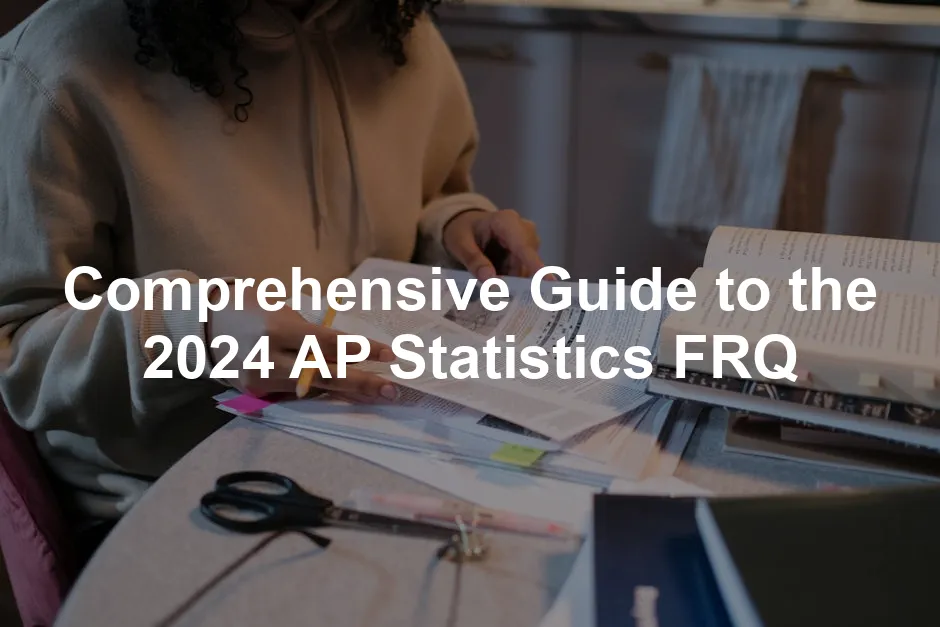Introduction
The AP Statistics exam is an essential component of the Advanced Placement curriculum. It helps high school students gain a deeper understanding of statistical concepts and prepares them for college-level coursework. Each year, students across the nation take this exam to demonstrate their knowledge and skills in statistics, making it a crucial stepping stone for aspiring data scientists, statisticians, and analysts.
One of the most significant parts of the exam is the Free Response Questions (FRQs). These questions challenge students to apply their understanding of statistics in a practical context. Unlike multiple-choice questions, FRQs require a deeper level of critical thinking and problem-solving. Students must not only find the right answers but also clearly communicate their reasoning and methodology.
The 2024 AP Statistics exam is scheduled for May 7, 2024. As always, it will include two sections: Multiple-Choice and Free Response. The exam is designed to test students on various statistical concepts, including data analysis, probability, and hypothesis testing. Students can expect a mix of familiar topics and new questions that reflect recent developments in the field.
In this guide, we will cover everything students need to know to tackle the 2024 AP Statistics FRQs successfully. From understanding the exam structure to reviewing essential topics, this resource aims to equip students with the tools they need for success on test day. Buckle up, because mastering the FRQs might just be the key to unlocking a world of opportunities in data analysis and beyond!

Section 1: Overview of the 2024 AP Statistics Exam
Exam Structure
The AP Statistics exam consists of two main sections: Multiple-Choice and Free Response. Each section is equally weighted, contributing 50% to the overall exam score.
In the Multiple-Choice section, students will face 40 questions that must be completed in 90 minutes. This portion tests students on their ability to quickly analyze data, interpret statistical results, and apply statistical reasoning.
The Free Response section features 6 questions, also to be completed within 90 minutes. This section is divided into two parts: Part A and Part B.
- Part A (65 minutes) includes 5 multipart questions focusing on various skills, such as collecting data, exploring data, probability, and inference.
- Part B (25 minutes) consists of one investigative task that assesses multiple skills and content areas.
This format ensures a comprehensive evaluation of a student’s statistical understanding and application skills.
Key Dates and Logistics
The AP Statistics exam will take place on Tuesday, May 7, 2024, at 12:00 PM local time. Students should check with their schools for specific details regarding the exam location and any necessary materials they need to bring.
Speaking of materials, it’s crucial to have the right tools at your disposal. Consider investing in an AP Statistics Prep Book to boost your study game. It’s packed with practice questions and tips that can help turn that anxiety into confidence!

Scoring Overview
The AP Statistics exam uses a unique scoring system. Each correct answer in the Multiple-Choice section adds to a student’s total score, while incorrect answers do not incur penalties.
The Free Response section is graded based on a standardized rubric. Each question is worth a set number of points, typically ranging from 0 to 4. The scoring system for the FRQs emphasizes clear communication, logical reasoning, and accurate application of statistical concepts.
In recent years, the score distribution for AP Statistics has shown a positive trend. A significant percentage of students achieve a score of 3 or higher, indicating a solid understanding of the material. This year, students can look forward to similar expectations, with the potential for even more students earning high scores as they prepare diligently for the exam!
To help you stay organized during your preparations, consider using a Study Planner. It’s a fantastic way to map out your study sessions and ensure you cover all the necessary topics without the last-minute panic!

Section 2: Breakdown of the 2024 AP Statistics FRQs
2024 Free Response Questions
The 2024 AP Statistics exam features a variety of intriguing topics for its Free Response Questions (FRQs). Here’s a sneak peek at what students will encounter:
- Online Fitness Classes: This question focuses on analyzing data from a survey about participants’ experiences with online fitness classes. Students will be asked to interpret results and draw conclusions based on statistical analysis, emphasizing concepts of sampling and variability.
- Bottles Fund Raiser: Here, students will explore the effectiveness of a fundraiser involving bottle recycling. They must analyze the data collected and evaluate the success of the fundraising efforts, touching on measures of center and spread.
- James Model D Car MPG: This question examines the miles per gallon (MPG) statistics for James’ Model D car. Students will need to apply their knowledge of linear regression and correlation to understand the relationship between different variables influencing MPG.
- Conrad Red Crystals: In this question, students investigate the distribution of red crystals in a chemical experiment. Statistical inference will be key here, as students must determine confidence intervals and hypothesis tests based on the collected data.
- Michelle Baseball Cards: This scenario revolves around Michelle’s baseball card collection. Students will analyze the value and distribution of the cards in her collection, employing statistical methods to support their conclusions about potential market value and trends.
- Julio Whistle Price: Julio’s pricing strategy for his handcrafted whistles will be the focus here. Students must analyze how different factors affect the price of these whistles, utilizing concepts of regression analysis and price elasticity.
Each of these questions not only tests students’ understanding of statistical concepts but also their ability to communicate their findings effectively.

Expected Skills and Concepts
To tackle these FRQs successfully, students need to master several key statistical skills and concepts:
- Data Interpretation: Understanding how to read and analyze data is vital. Students must be adept at interpreting various statistical representations, including graphs and tables.
- Statistical Measures: Proficiency in calculating measures of center (mean, median, mode) and measures of spread (range, quartiles, standard deviation) is essential for many of the questions.
- Probability and Inference: Students should be comfortable with probability calculations and statistical inference techniques. This includes constructing confidence intervals and conducting hypothesis tests.
- Regression Analysis: For questions that involve relationships between variables, mastery of linear regression and correlation coefficients is crucial.
- Clear Communication: It’s not just about getting the right answer; students must clearly justify their reasoning and calculations. Properly articulating their thought process is a significant part of scoring well on FRQs.
- Problem-Solving: Students must approach each question with a problem-solving mindset, breaking down complex scenarios into manageable parts and applying the appropriate statistical techniques.
The importance of clear communication cannot be overstated. Students must present their findings logically and coherently, ensuring that their reasoning is easy to follow. This skill is not only crucial for the AP exam but also invaluable in real-world applications of statistics.
In conclusion, the 2024 AP Statistics FRQs will challenge students to apply their knowledge in practical scenarios. Mastering the relevant statistical skills and communicating insights effectively will be key to success. So, gear up, practice diligently, and approach those FRQs with confidence!

Section 3: Strategies for Tackling FRQs
Preparation Tips
Preparing for the Free Response Questions (FRQs) on the AP Statistics exam can feel like gearing up for a thrilling roller coaster ride—full of twists and turns! But fear not, because with the right strategies, you can ride smoothly through it all.
First and foremost, practice makes perfect. Familiarize yourself with the structure of the FRQs. Use past FRQs from the College Board’s website as a benchmark. These questions offer a glimpse into the types of problems you might encounter. You can find a treasure trove of them at AP Central.
Next, grab some review books designed specifically for AP Statistics. They provide summaries of key concepts and practice questions. Look for those that offer detailed explanations for each answer. Understanding why an answer is correct—or incorrect—is just as crucial as getting it right!
Another effective study habit is to create a study schedule. Break your study sessions into manageable chunks. Spend time on each unit, emphasizing areas where you feel less confident. This approach keeps your brain fresh and engaged, preventing that dreaded burnout.
Don’t forget to check out online resources! Websites like Fiveable offer interactive study sessions and a plethora of practice questions. It’s like having a personal tutor available at your fingertips.
When practicing, pay close attention to the scoring rubric provided by the College Board. Understanding how your answers will be graded can give you a crucial edge. Aim to meet the criteria outlined in the rubric; clarity, logical reasoning, and thorough explanations are your best friends here.
To help with your study sessions, having a reliable Graphing Calculator is essential. It allows you to visualize data and perform complex calculations quickly, making it a must-have for exam day!

On Exam Day
Ah, exam day! It’s time to put all that preparation into action. Remember, timing is everything. You have 90 minutes to tackle the FRQ section, so manage your time wisely. A good rule of thumb is to allocate about 15 minutes for each of the five multipart questions in Part A and save the remaining time for the investigative task in Part B.
Start by skimming through all the questions. Identify which ones you feel most comfortable with and tackle those first. This strategy helps build your confidence and ensures you secure points early on.
When it comes to structuring your answers, clarity is key. Begin with a brief introduction that outlines your approach to the problem. Follow this up with the body of your answer, where you provide detailed calculations or explanations. Wrap it up with a conclusion that summarizes your findings. This structure not only helps you stay organized but also makes it easier for the grader to follow your thought process.
Use clear and concise language throughout your answers. Avoid jargon that might confuse the reader. If you’re using statistical terms, ensure you define them or explain their relevance to the problem at hand.
Lastly, remember to breathe! It’s easy to get flustered under pressure. Take a moment to collect your thoughts if needed. Keeping a calm mindset can make a significant difference in your performance.
By employing these strategies, you’ll be well on your way to mastering the FRQs of the 2024 AP Statistics exam. With preparation, practice, and a clear approach on exam day, you’ll be equipped to face those questions head-on. Good luck!

Section 4: Scoring Guidelines and Resources
Scoring Rubrics
Understanding how AP Statistics Free Response Questions (FRQs) are scored can feel like trying to decode hieroglyphics. But fear not! The scoring system is quite straightforward, and knowing it can significantly boost your chances of scoring well.
Each FRQ in the AP Statistics exam is graded on a scale of 0 to 4 points. The scoring guidelines assess several key components, including:
- Correctness: The accuracy of your answers is paramount. A correct answer gets maximum points.
- Reasoning: Examiners look for logical reasoning behind your calculations. Show your work!
- Communication: Clarity matters. Make sure your explanations are easy to follow and well-organized.
- Use of Statistical Language: Properly using statistical terminology can earn you extra credit, so don’t skimp on the jargon!
Common pitfalls can trip up even the most prepared students. Here are a few to watch out for:
- Skipping Steps: Make sure to show your calculations. Even if you arrive at the correct answer, skipping steps can lead to lost points.
- Vague Explanations: Don’t assume the reader knows what you’re thinking. Be specific in your explanations.
- Misinterpretation of the Question: Read each question carefully. Misunderstanding what is being asked can derail your entire response.
- Ignoring the Rubric: Familiarize yourself with the scoring rubric. Tailor your answers to meet the outlined criteria.
By avoiding these common pitfalls and adhering to the scoring guidelines, you’ll be well on your way to maximizing your FRQ scores!

Available Resources
Preparation is key, and thankfully, there’s a treasure trove of resources to help you ace the AP Statistics exam. Whether you prefer online platforms, study groups, or structured tutoring services, there’s something for everyone.
- Official College Board Resources: Start with the College Board’s own materials. They provide past FRQs, scoring guidelines, and sample responses that are invaluable for understanding what examiners expect. You can find these resources at AP Central.
- Online Learning Platforms: Websites like Fiveable offer a wealth of resources, including practice questions, study guides, and live cram sessions. Their interactive format makes studying less of a chore and more engaging.
- Tutoring Services: If you find yourself needing extra help, consider online tutoring. Services like Wiingy provide personalized tutoring sessions tailored to AP Statistics. Their experienced tutors can offer guidance on tough topics and help clarify complex concepts.
- Study Groups: Don’t underestimate the power of group study. Collaborating with peers can enhance your understanding and keep you accountable. Plus, explaining concepts to others is a fantastic way to reinforce your own knowledge.
- Review Books: A good AP Statistics review book can be a game-changer. Look for books that include comprehensive reviews of key concepts, practice questions, and detailed solutions. This way, you can tackle problem areas effectively. Consider grabbing a copy of the AP Statistics Practice Exams Book to get those practice questions in!
- YouTube Videos: Visual learners can benefit from countless educational videos. Channels dedicated to AP Statistics will often break down complex topics and provide step-by-step solutions to past FRQs.
With these resources at your disposal, you’ll be well-prepared to tackle the 2024 AP Statistics FRQs. So, gather your materials, form a study plan, and get ready to show those examiners what you’ve got!

FAQs
Don’t forget to keep your study area organized! A Desktop Organizer can help keep your materials at hand and reduce distractions. It’s a small investment for a big payoff in your study efficiency!

Please let us know what you think about our content by leaving a comment down below!
Thank you for reading till here 🙂
For a detailed overview of the essential topics covered in AP Statistics, check out our AP Statistics formula sheet.
All images from Pexels




